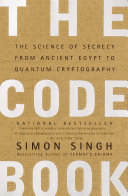

Cryptography has a rich history that dates back thousands of years, with its origins in ancient civilizations. The book chronicles the evolution of cryptographic techniques from simple substitution ciphers used by the Romans to the complex algorithms of modern computing. One of the earliest forms of cryptography was the Caesar cipher, where letters were shifted a certain number of places down the alphabet. The text delves into how cryptography was used in historical contexts, such as during wartime communications, where the need for secrecy was paramount. The book also discusses the impact of World War II on cryptography, particularly the efforts of the Allied forces to crack the Enigma machine used by the Nazis. This historical perspective is crucial as it lays the groundwork for understanding the importance of cryptography in contemporary society, especially in the digital age where communication is often vulnerable to interception. The narrative illustrates how cryptography has evolved in response to the changing landscape of technology and warfare, emphasizing the ongoing arms race between code makers and code breakers.
Continue readingAt the heart of modern cryptography lies complex mathematics, particularly number theory and algebra. The book introduces readers to concepts such as prime numbers, modular arithmetic, and algorithms like RSA (Rivest-Shamir-Adleman), which are foundational to secure communications. RSA, for instance, relies on the difficulty of factoring large prime numbers, a task that is computationally intensive and forms the basis of public-key cryptography. This section of the book demystifies the mathematical principles that underpin cryptographic systems, making them accessible to readers without a strong mathematical background. It also highlights the relationship between mathematical discoveries and their applications in securing information, illustrating how breakthroughs in mathematics have led to advancements in cryptography. The book emphasizes that understanding these mathematical concepts is essential for grasping how modern encryption works and the potential vulnerabilities that exist if these mathematical foundations are compromised.
Continue readingCryptography plays a critical role in ensuring the security of information in various domains, including personal communication, financial transactions, and national security. The book discusses how encryption protects sensitive data from unauthorized access and the implications of data breaches in the digital age. It explores real-world examples, such as the use of encryption in online banking and e-commerce, where secure transactions are vital for consumer trust. The text also addresses the balance between security and privacy, particularly in the context of government surveillance and law enforcement. It raises ethical questions about the extent to which governments should have access to encrypted communications in the name of national security. By examining these issues, the book prompts readers to consider the broader implications of cryptographic technologies on society, including the ongoing debates about privacy rights and the potential for misuse of surveillance technologies.
Continue readingThe book outlines the progression of encryption techniques, from classical methods to modern algorithms. It describes how early ciphers, such as the Vigenère cipher, were eventually replaced by more secure methods as the need for stronger encryption grew. The text delves into symmetric and asymmetric encryption, explaining their differences and applications. Symmetric encryption involves the same key for both encryption and decryption, while asymmetric encryption uses a pair of keys (public and private) to enhance security. The book also covers the development of advanced encryption standards (AES) and their significance in contemporary cryptography. This evolution reflects the ongoing cat-and-mouse game between cryptographers and hackers, where each advancement in encryption techniques is met with attempts to break them. Understanding this evolution is essential for appreciating the current state of cryptography and the challenges that lie ahead in securing information.
Continue readingQuantum computing represents a significant challenge to traditional cryptographic methods. The book explores how quantum computers, with their ability to perform complex calculations at unprecedented speeds, could potentially break widely used encryption algorithms like RSA and ECC (Elliptic Curve Cryptography). It discusses the concept of quantum supremacy and the implications of quantum algorithms, such as Shor's algorithm, which can factor large numbers efficiently. The text emphasizes the urgency of developing quantum-resistant cryptographic algorithms to safeguard data against future quantum threats. This section of the book highlights the need for ongoing research and adaptation in the field of cryptography, as advancements in technology continue to reshape the landscape of information security. It serves as a call to action for cryptographers and technologists to prepare for a future where quantum computing may render traditional encryption methods obsolete.
Continue readingThe ethical implications of cryptography are a recurring theme in the book. It raises questions about the responsibility of cryptographers in balancing security and privacy, especially in an era where digital surveillance is prevalent. The text discusses the potential for encryption to be used for both good and bad purposes, such as protecting civil liberties versus facilitating criminal activities. It also addresses the role of governments and corporations in regulating encryption technologies and the potential consequences of restricting access to strong encryption. By exploring these ethical dilemmas, the book encourages readers to think critically about the societal impact of cryptographic technologies and the moral responsibilities of those who create and implement them. This discussion is particularly relevant in today's world, where the lines between security, privacy, and freedom are increasingly blurred.
Continue readingThe future of cryptography is a topic of great importance as technology continues to evolve. The book speculates on emerging trends and potential advancements in cryptographic techniques, including the integration of artificial intelligence and machine learning in encryption processes. It discusses the importance of staying ahead of potential threats, particularly in light of rapid technological advancements and the rise of cyber warfare. The text emphasizes the need for continuous innovation and adaptation in the field of cryptography to ensure that secure communication remains viable. Additionally, it highlights the role of international collaboration in developing global standards for encryption and addressing transnational cyber threats. This forward-looking perspective encourages readers to consider the ongoing challenges and opportunities in cryptography, prompting them to engage with the future of information security.
Continue reading